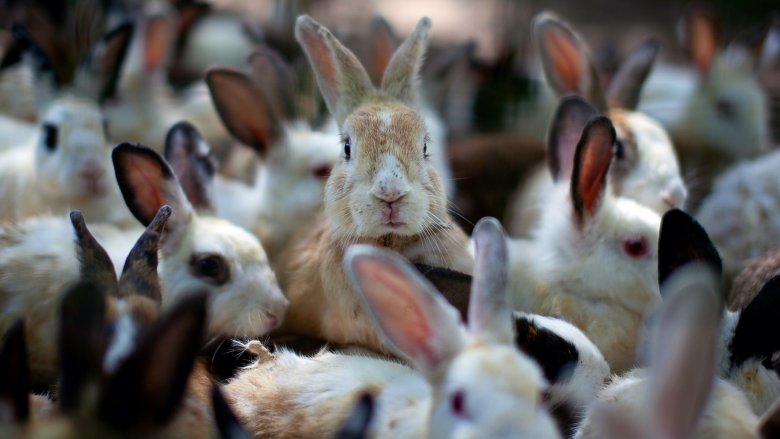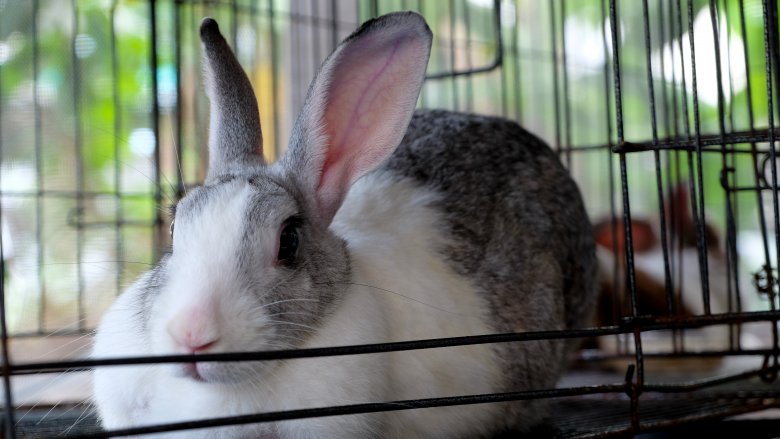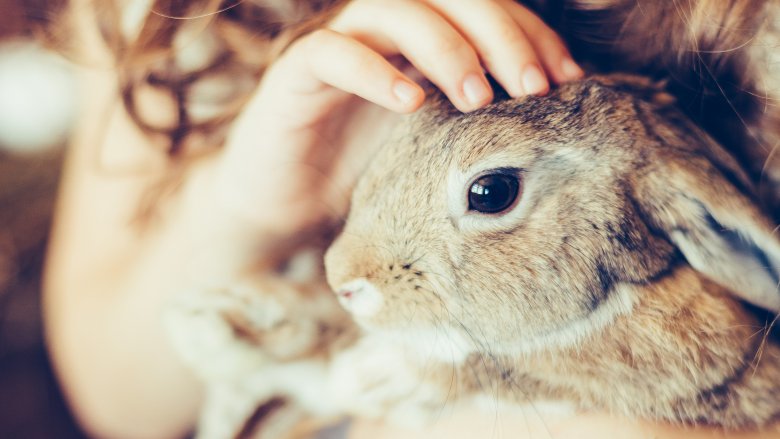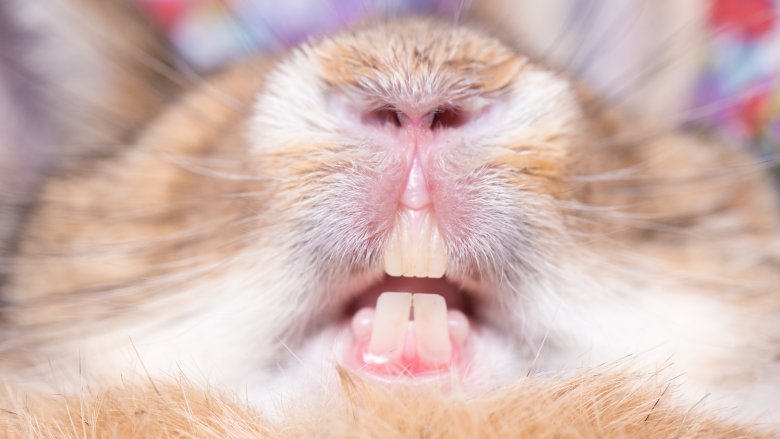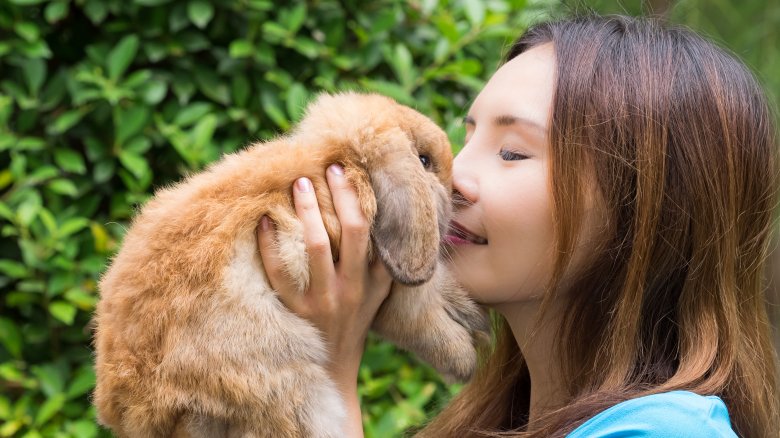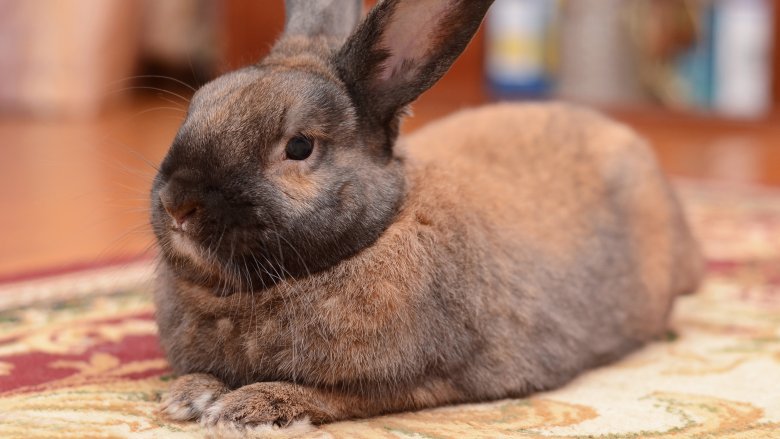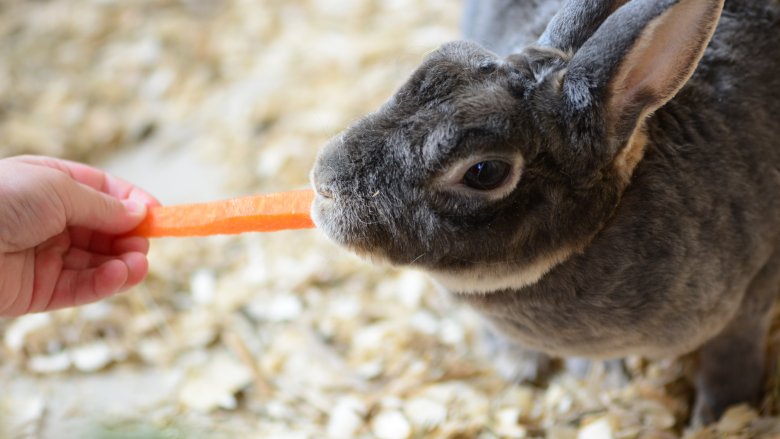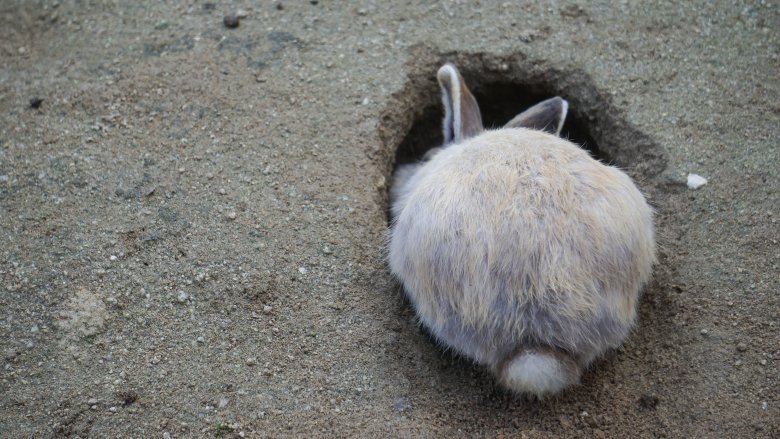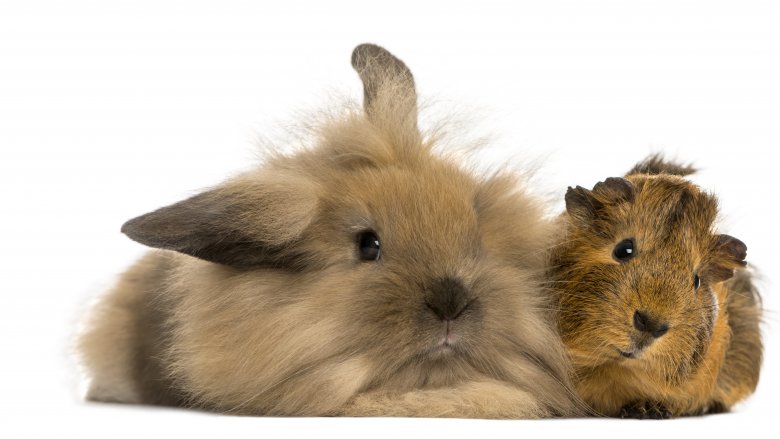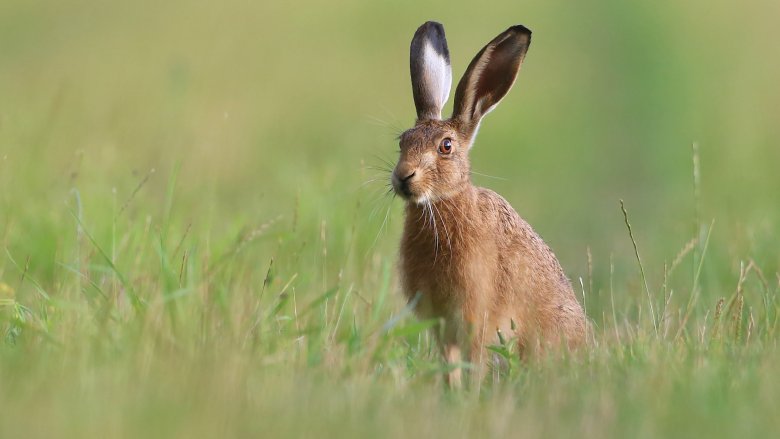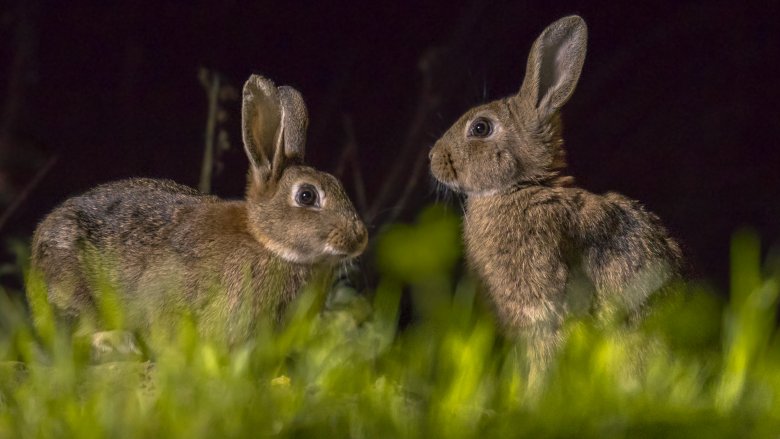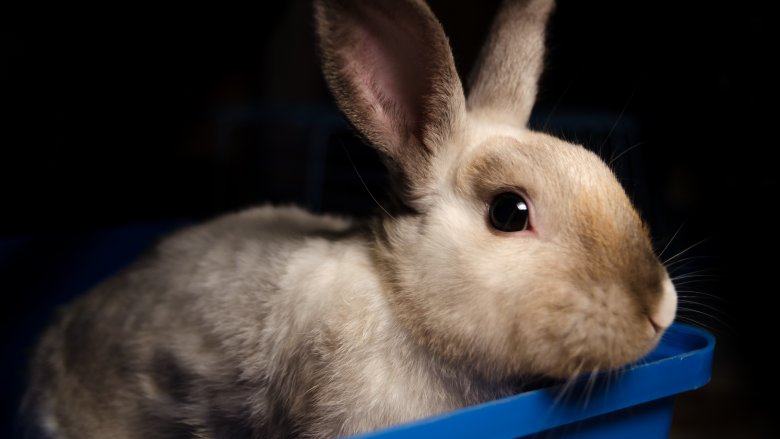This Is What Everyone Gets Wrong About Rabbits
Bunnies are cute, soft, and they have twitchy noses. (And who can resist a twitchy nose, right?) As household pets go, they may not be as popular as cats or dogs, but they actually do have some superior qualities. Unlike dogs, they don't slobber all over you or get friendly with your significant other's leg. And unlike cats, they don't look at you as if you're inferior and they're just waiting for you to die so they can sustain themselves for weeks on your decomposing corpse. So really, it seems kind of weird that every home doesn't contain a rabbit — aren't they like the world's most perfect pet?
Not really. In fact as far as loyalty and cuddliness is concerned, rabbits kind of come up a bit short. And although well-educated rabbit owners can get along very well with their cotton-tailed companions, the rest of us should probably correct our common misconceptions before adding a bunny to the family.
Bunnies are conveniently temporary
Bunnies are popular Easter pets. Some parents, though they probably won't admit it out loud, will buy their kids a bunny for Easter because they're secretly thinking to themselves, "Well, at least it won't live very long and I'll only be stuck taking care of it for a little while after Junior gets tired of it." But surprise! A domesticated rabbit can live almost as long as a cat — up to 12 years versus 15 years for the average human flesh-coveting feline. (Not that all felines are coveting owner kibble, but you know some of them are.)
In the wild a rabbit may only live two or three years, but that's not because rabbits don't have the constitution to lead long and healthy lives. It's because their lives suck and everything wants to eat them. According to PetMD, domesticated rabbits live four times longer than wild rabbits because their captive environment is safe and secure. Their wild cousins, on the other hand, live in a disease-abundant, food-insecure, and predator-filled environment, which is the exact opposite of safe and secure. (Now that you feel really sorry for wild rabbits, though, don't be tempted to catch one and take it home to the safety and security of captivity because wild bunnies don't adapt well to life with humans.)
Anyway, parents hoping their kids' bunny would be a temporary pet might want to consider a hamster instead. They're totally awful but they only live for a couple of years. Otherwise there are always fish.
Rabbits can be cuddled
Rabbits look really cuddly. After all, if they weren't meant to be cuddled, why did Mother Nature give them such soft fur? But sadly, despite the super-soft fur coat, rabbits are kind of the opposite of cuddly. They aren't like puppies, which crave human attention and will quite happily hang out on your lap all afternoon, or like cats, which will jump on your lap but only when it suits them and only because they sense weakness. Rabbits are prey animals, so when you pick one up they go, "Crap! I'm going to be eaten!"
According to the Indiana House Rabbit Society, a rabbit that's accustomed to its owner may enjoy being petted, but most rabbits don't appreciate being held or carried. Rabbit owners are advised to hang out with their pets on the floor, and pet them when they approach, which is way less scary for them than sweeping them up into a forced cuddle. And it's important to know how to pick up a rabbit, too, because they have strong back legs that are designed for escaping, so if you aren't careful a frightened rabbit will kick and scratch you rather than submit to the horrors of human affection.
They won't bite or scratch your holy terror of a toddler
Actually, rabbits totally bite and scratch. If they didn't, they wouldn't have gotten very far as a species. It's not just predators that need to be aggressive in order to survive — prey animals need that, too, because once they're caught there's still hope of being able to bite and scratch their way out of a bad situation. And your holy terror of a toddler definitely counts as a bad situation.
According to the House Rabbit Society, some rabbits can become so aggressive that their owners don't feel like they can handle them. Yes, that's right, Monty Python wasn't actually being funny with the whole killer rabbit thing — some rabbits really do bite, kick, lunge, and chase their owners. Aggressive behavior in rabbits is most common at the age of 4 months or so, when the rabbit is reaching the equivalent of puberty, so really, you can consider it somewhat on par with your teenager's habit of eye-rolling, door-slamming, and engaging in long Fortnite marathons without food or water.
Anyway, the good news is aggressive behavior in rabbits can be fixed — sometimes literally fixed if the rabbit gets spayed or neutered before the problem gets out of control. Time, patience, and good training techniques will fix the majority of remaining aggressive behavior. If only the Rabbit of Caerbannog had had educated owners, The Holy Grail would have been a very different movie.
Rabbits are low-maintenance
Another reason why you might be tempted to buy a rabbit for your child is because you've heard they don't require a lot of care. You don't need to vaccinate them, they don't really crave attention, and they have only basic food and shelter requirements.
According to PetMD, none of that is true. Rabbits do need daily care, and they especially need an owner who is attentive to even minor changes in personality or behavior. While it's fairly easy to tell if a dog or cat is not feeling well, rabbits are a lot more subtle. Because a rabbit is a prey animal, its instinct is to keep its weaknesses hidden. Predators always go after the weakest targets, so it's in a rabbit's interests to seem healthy and robust even when it's not. So by the time it becomes obvious that a rabbit is sick, it may be too late to save it. Owners who give their rabbits daily attention will be better able to detect small changes in personality, eating, or bathroom habits, which can mean the difference between timely medical attention and death.
Not only that, but rabbits are social creatures, and they need attention and mental stimulation. Without it, they get bored and can develop bad habits or even become depressed. So prospective pet owners who were hoping for low maintenance are better off with a reptile — snakes and lizards don't really give a crap about love and attention.
Wascally Wabbits
You can probably leave your cats at home without having to worry too much that they'll invite the local strays over for catnip and the wanton destruction of your walls and furniture. Most dogs do okay at home alone, too, except for the occasional few who try to self-treat their separation anxiety by filling the living room with the soothing, cloud-like innards of the family sofa. You probably don't think a rabbit would be much different than a cat or a well-adjusted dog, but you're wrong — with their sharp incisors and love of chewing, a rabbit can make short work of your baseboards and worse, your electrical cords.
Rabbit chewing isn't like dog chewing — you can't just get your bunny a piece of rawhide and expect it to stay away from every other chewable surface in your home. According to Spruce Pets, rabbits will chew up the walls, and they are particularly fond of electrical cords, so if you're not keeping an eye on them they could actually electrocute themselves. So you can't just turn a rabbit loose and then go off in the next room to watch Outlander. At best, owners could hide every electrical cord in the house or buy conduits for them, but that's still no substitute for keeping an eye on a roving bunny. Most rabbit experts think it's best to give a rabbit a home base or cage so it has a safe place to go when play time is over.
Can't we all just get along?
Logic might tell you that a rabbit cannot coexist with a dog or a cat. Rabbits are prey, and dogs and cats are predators, so it kind of seems like a no-brainer that they should be kept separated.
It might be surprising, then, to hear that this is not entirely true. First of all, a full-grown rabbit might actually be able to take down a flesh-hungry feline, so a wise cat won't usually attempt to turn Bun into a meal. Dogs, on the other hand, are a bigger problem, especially large dogs, who could be tempted to snack on a pet rabbit while its owner is looking the other direction.
That doesn't necessarily mean dogs can't learn to get along with rabbits, though. According to VetStreet, peaceful coexistence between canine and leporine (that's fancy for "rabbit") depends a lot on the individual animals. A jumpy rabbit may actually trigger a dog's predatory instincts, so it's not a great idea to pair that personality with, say, a beagle. A rabbit that doesn't seem fazed by much is a better companion for a dog. And dogs raised with rabbits will be more likely to see them as family members rather than fluffy kibble.
Dogs and rabbits should never be left alone together, though, even if they're the best of pals. Because you really just never know when Fido is going to decide he's been wrong all these years.
Bugs Bunny's carrot was just part of his badass image
Bugs Bunny always had a carrot his hand, which in retrospect is actually really weird since rabbits don't have hands. But still, the rabbits-love-carrots stereotype is a part of collective human consciousness, just like the goats-love-tin-cans stereotype. And because no one ever thinks to question things that are part of human consciousness, it may come as a surprise to you that carrots are actually bad for rabbits. So really, Bugs Bunny's carrot was sort of akin to James Dean's cigarette: It was just a part of his bad boy image.
It's not that rabbits don't like carrots and won't eat them — they will, but according to the Telegraph, carrots and other root vegetables are not natural food for rabbits and eating them can actually lead to health problems. Carrots are high in sugar, so they can cause tooth decay and weight gain. So basically, that orange vegetable you force yourself to eat when you're dieting actually makes rabbits fatter. So what's left for the rabbit who's watching his midsection, iceberg lettuce? Actually, no! Rabbits shouldn't even eat iceberg lettuce because it contains lactucarium, a chemical that can give rabbits a fatal case of diarrhea. In conclusion, dieting as a rabbit would totally suck.
All one big, happy, underground family
Domesticated rabbits resemble their wilder cousins, but domesticated rabbits have hundreds of years of selective breeding separating them from wild rabbits. And American wild rabbits have all those centuries of breeding and an entire ocean between themselves and hutch bunnies — they're so different from each other that it's hard to imagine they're actually related.
Pop culture and movies like Watership Down have taught us that rabbits are social creatures that live in colonies underground, but that is only true for certain kinds of rabbits. The common domesticated rabbit is descended from a European species that lives in large underground warrens, which is part of the reason they make good pets: They're naturally adapted to a hierarchical society such as that of a human family.
American rabbits aren't like their European counterparts. Most wild American rabbits don't dig burrows, though they will live in the abandoned burrows of other animals. They'll usually seek shelter in thick vegetation. And they're not always very social animals, either — according to Cotton Feathers, the American cottontail is territorial and solitary. So all that Watership Down camaraderie only exists in European rabbits and in fiction. And also, rabbits don't talk, feed seagulls, or ride on boats either. Just in case you weren't clear.
I chew, therefore I'm a rodent
A couple hundred years ago, people thought rabbits and rodents were pretty much the same thing. The rodent's Latin name, rodentia, comes from "rodere," meaning "to gnaw," and rabbits do love to gnaw. The confusion may also have come from the equally bad rap rabbits and rodents had — they were both seen as vermin, so it was probably tempting to just lump them all into the same category. Wild rabbits would get into people's yards, eat their vegetables, poop all over everything, dig holes in the ground, and generally make life complicated for anyone with a garden. Rats would do the same thing, but in people's homes and outbuildings.
But according to the Oxford Dictionary, rabbits aren't actually rodents — they're a part of the order Lagomorpha, in the class Leporidae. In fact rabbits are actually quite different from rodents — they are strictly herbivores, while rodents are opportunistic feeders and will eat meat as well as vegetables if that's what's available. Rabbits also have four incisors instead of just two. And rabbits are cute, soft, and petable, while rodents are hideous disease-carrying harbingers of plague and hantavirus, so there's that.
Rabbits and hares are the same thing
It's easy to get a hare mixed up with a rabbit — they look sort of similar, except rabbits are cute and hares look like rabbits that lost a battle with a taffy pulling machine. But hares and rabbits aren't just subsets of the same animal — they're different in both appearance and behavior and are considered two different species. In fact according to National Geographic, hares and rabbits are as different from each other as sheep are from goats.
Besides the long and lanky look of most hares compared to the shorter, squatter look of a rabbit, the major difference between the two species is evident at birth. Baby rabbits are a lot like puppies or feline kittens — they're altricial, which means they're fully dependent on mom for the first few weeks of life. Rabbit kittens are born helpless, furless, and with their eyes closed. Newborn baby hares, on the other hand, actually have more in common with baby horses than baby rabbits. They are precocial (more advanced) — their eyes are open, they have all their fur, and they can run just seven days after birth.
Hares live in open spaces, so they depend on speed to keep from becoming fox food. A hare can run much faster than the average rabbit, up to 40 mph. For contrast, the desert cottontail can only manage about half that much speed.
Rabbits love the darkness
One female rabbit can theoretically produce as many as 1,000 new bunnies in a single lifetime. Now granted, wild bunnies don't live long enough to have that many offspring, but even if one bunny could have 200 or 300 babies in a lifetime, that's a lot of bunnies. So why aren't we all wading through bunnies every time we go out for a little wilderness exploration? Is it because rabbits are nocturnal, and therefore do not flood the land with their furry bodies until after the sun goes down?
Well, for a start, wild rabbits are pretty susceptible to disease and predation, so tragically few of those offspring will survive long enough to produce more offspring. But the other reason we hardly ever see bunnies is not because they nocturnal but because they are crepuscular.
According to the House Rabbit Society, rabbits come out of their burrows (or brier patches) at twilight. As a survival strategy that's pretty genius because it means not only are they likely to be missed by nocturnal predators, which have eyes that are accustomed to hunting in full darkness, they're also likely to be missed by daylight predators, who would also not be very good at spotting a rabbit foraging in the dim twilight.
Rabbits are easy to litter train
As pets go, cats are pretty easy. Sure, they may be waiting around for you to die, but at least you know pretty much exactly where they're going to poop. To litter train a cat, you really just need to put out a box of litter and clean it semi-regularly. You may have heard that rabbits are similarly easy to litter train, but unfortunately that's just not the case. It can be done, but it takes a little bit of work.
First, rabbits that aren't fixed like to mark their territory, which means they poop or pee in it (awesome). So according to the House Rabbit Society, the first step toward litter training a rabbit is to get it fixed. And you can't just buy some cat litter and be done with it. Rabbits like to hang out in their litter boxes, and they also like to eat their litter (yum), and their pee also stinks. So they need non-toxic yet absorbent litter, and a little hay on top so they can have a snack while they're doing their business.
Even a properly litter-trained rabbit won't always use the litter box, though. Even fixed rabbits will sometimes "mark" territory or poop around the litter box as well as in it. So generally speaking, litter training a rabbit is not as simple as litter training a cat. Of course, a rabbit isn't waiting around for you to die so he can feast on your dead body, so perks.
